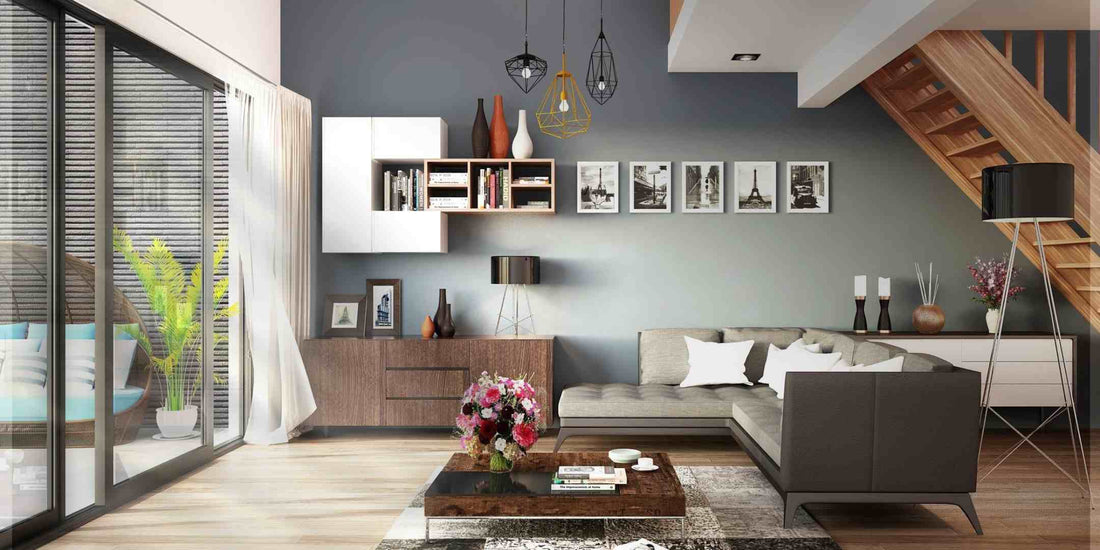
The Art of Layering Textures in Interior Design
Share
Suppose there’s one thing that separates a Pinterest-worthy space from one that feels flat and uninspired. In that case, it’s this: layering textures in interior design.
You can paint a room the perfect sage green, hang the trendiest rattan pendant light, and splurge on a statement couch—but without texture? It falls flat. Texture is the quiet hero. It creates depth, coziness, contrast, and that elusive "wow" factor.
Let’s delve into the transformative power of layering textures in interior design, a technique that even the most compact condo units or HDB flats can't resist. It empowers you to turn any space into a cozy haven, sparking excitement about the potential of your living space.
What is Layering in Interior Design?

In simple terms, layering in interior design is the practice of combining different design elements—materials, fabrics, finishes, shapes, colors, and, yes, textures—to create a cohesive and visually rich space. It’s like putting together a good outfit: jeans + tee is a look, but add a denim jacket, gold hoops, leather boots, and you’ve got a vibe.
Layering textures adds nuance. It's not just about seeing a room; it's about feeling it. A velvet sofa beside a jute rug. Smooth ceramic vases sitting on a reclaimed wood shelf. Linen curtains brush against a concrete wall. It’s a sensory and emotional experience that deeply connects you to your living space, making it more than just a place but a part of you.
Why Texture Matters So Much
Texture is how a space feels, both literally and visually. It can:
- Soften cold spaces
- Add contrast to monochromatic palettes
- Make minimalism feel cozy, not sterile
- Enhance lighting by playing with surfaces
Even in the smallest of spaces, texture plays a crucial role. Small details—such as a fringed pillow or a hammered metal lamp—contribute to a room's overall tactile appeal. In places where natural light is limited, and room sizes are tight, texture adds dimension without clutter, giving you the confidence to design your space effectively.
Types of Textures in Interior Design

So, what are the types of textures in interior design?
Textures come in two main categories:
1. Tactile Texture
You can touch and feel this one. Think of materials with actual surface variations:
- Woven fabrics like boucle, linen, chenille
- Natural elements like rattan, jute, bamboo, and wood grains
- Stone, concrete, brick
- Leather, suede
- Glass (smooth), metal (cool and hard)
2. Visual Texture
This is more about how something looks, like it might feel. Even a flat wallpaper can look textured if it has a marble or textile pattern. Examples include:
- Faux finishes (e.g., faux bois, faux marble)
- Patterned wallpapers
- Photographic prints
- Painted or distressed furniture
A well-balanced room uses a bit of both. This principle of balance in texture combinations will guide you in creating a space that feels harmonious and inviting.
Layering Textures: Interior Design Ideas
Let’s get into the good stuff. Here are specific layering textures and interior design ideas that actually work, even in small homes.
1. Start from the Ground Up

The floor is your foundation for layering. Consider mixing these:
- A low-pile rug on top of hardwood floors
- Layering a smaller patterned rug on top of a neutral jute rug
- Textured vinyl or stone-look tiles in the kitchen for durability and depth
2. Mix Soft and Hard Materials

Contrast is your friend:
- A soft velvet couch against a concrete accent wall
- Wicker or cane dining chairs beside a sleek glass table
- A chunky knit throw over a smooth leather armchair
These juxtapositions are what make a room feel dynamic.
3. Play with Patterns

Patterns act as visual textures, even if they're printed. Don’t be afraid to combine:
- Geometric prints with florals (balance is key)
- Tone-on-tone patterns like herringbone, chevron, or lattice
- Subtle wallpaper with layered art and mirrors
4. Use Natural Elements

Incorporate these timeless textures:
- Indoor plants with leafy texture (monstera, ferns)
- Rattan baskets, bamboo blinds
- Stone bowls, ceramic vases
- Exposed brick or wood beams, if you’re lucky enough to have them
These also help ground the space and connect it to nature.
5. Layer Window Treatments

Why settle for one curtain when you can have two?
- Combine sheer linen panels with heavier drapes
- Add a bamboo shade underneath fabric curtains for depth
This also allows you to control light and privacy more effectively.
6. Textured Wall Art and Decor

Flat canvas art is excellent, but textured wall decor adds more life:
- Macrame wall hangings
- Shadow box art
- 3D wall panels or wood slat accents
You can also hang baskets or framed textiles as statement pieces.
Pro Tips
Stick to a Color Palette: Too many colors with too many textures = chaos. Neutrals let textures shine.
Use the Rule of Three: Pick three main textures to work with and build around them. For example, you might choose a plush fabric like velvet, a natural material like wood, and a sleek surface like glass. By incorporating these three textures in various elements of your design, you can create a cohesive and visually interesting space.
Don’t Forget the Ceiling: Yes, the "fifth wall." Coffered ceilings, wood beams, and even textured paint finishes can elevate a space.
Layer Functionally: Every texture should have a purpose—whether it’s warmth, visual interest, or sound absorption.
Balance Smooth and Rough: Too much of either throws the room off. If you have lots of plush elements, add some raw or industrial touches to ground it. For instance, if you have a velvet sofa, balance its softness with a raw wood coffee table or an industrial metal lamp. This juxtaposition will add depth and interest to your space.
Quick Texture Combos That Always Work
Here are some no-fail combinations that instantly elevate any room:
- Velvet + Brass + Marble: Luxe, elegant, modern

- Linen + Wood + Wicker: Earthy, casual, coastal

- Concrete + Leather + Glass: Industrial chic

- Boucle + Painted Walls + Black Metal Accents: Trendy but timeless

Final Thoughts
Mastering the art of layering textures in interior design is less about following rigid rules and more about trusting your senses. If a space feels balanced and enjoyable, it usually is. Start small. Layer a throw pillow. Swap out a lamp. Add a wood tray or textured bowl.
When you embrace texture, your space begins to tell a story—one of comfort, creativity, and lived-in, beautiful elegance. Whether you’re in a tiny apartment or a full-sized home, the right layers will always make your space feel more like you.
P.S. Texture is also your best friend if you’re decorating on a budget. You don’t need expensive furniture to make a space look rich. You just need the right mix of materials.
Ready to layer up?
